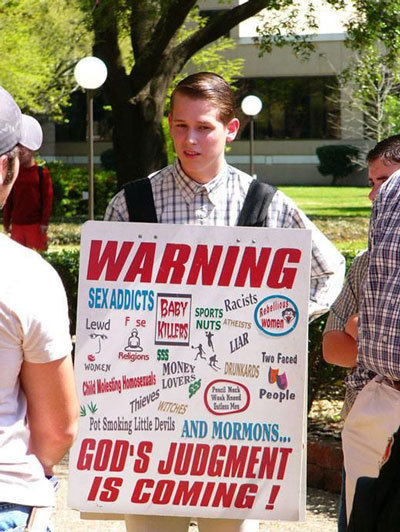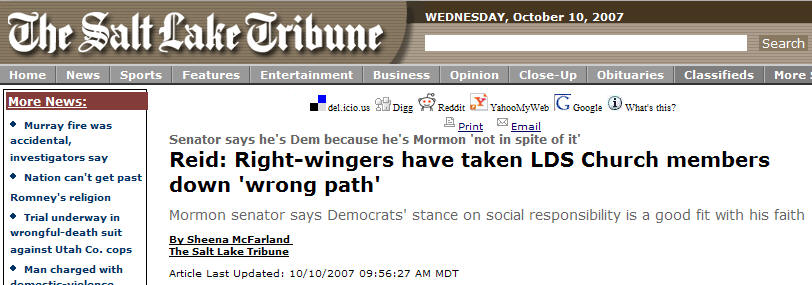And now for something completely different.
One of my treasured books — which I begged of my mother-in-law, and which she generously gave to me — is a bound volume of all 1951 issues of The Relief Society Magazine (Vol. 38, Nos. 1-12). The Relief Society Magazine (TRSM) was a small, semi-glossy official monthly publication of the Relief Society of the Church of Jesus Christ of Latter-day Saints. Like the contemporaneous general Church magazine, The Improvement Era, TSRM carried paid advertising (Orson Scott Card quipped in Saintspeak that when The Ensign replaced The Improvement Era, the advertising function was taken over by BYU Magazine). Each issue appears to be roughly 70-75 pages long.
I thought I’d reproduce the table of contents of a single issue: January 1951 (Vol. 38, No. 1); I’ve dropped the page numbers and reformatted a bit:
SPECIAL FEATURES
- A New Year Wish — General Presidency of Relief Society
- Ernest L. Wilkinson, President of Brigham Young University — Ivor Sharp
- Award Winners: Eliza R. Snow Poetry Contest
- Lot’s Wife (First Prize Poem) — Alice Morrey Bailey
- Old Home (Second Prize Poem) — Julia M. Nelson
- Pioneer Wagon Wheels (Third Prize Poem) — Ruth Horsley Chadwick
- Award Winners: Annual Relief Society Short Story Contest
- “But Covet Earnestly” (First Prize Story) — Mirla Greenwood Thayne
- Polio Strikes Again
- Pioneering in the Big Horn Basin — Botilda Berthelson McBlain
FICTION
- A Christmas Gift for Teacher — Fae Decker Dix
GENERAL FEATURES
- Sixty Years Ago [these are excerpts from the Woman’s Exponent, 1891]
- Woman’s Sphere — Ramona W. Cannon
- Editorial: The Old and the New — Vesta P. Crawford
- New Serial (“For the Strength of the Hills”) to Begin in February
- Notes to the Field: Relief Society Assigned Evening Meeting of Fast Sunday in March; Bound Volumes of 1950 Relief Society Magazines; Award Subscriptions Presented in April; Relief Society Not a Selling Agent; Pictures of all General Presidents of Relief Society Available
- Notes from the Field: Relief Society Socials, Bazaars, and Other Activities — Gen. Sec’y-Treasurer, Margaret C. Pickering
- From Near and Far
LESSON DEPARTMENT
- Theology: “The Long Night of Apostasy” — Don B. Colton
- Visiting Teaching Message: “And Jesus Answering Saith Unto Them…” — Mary Grant Judd
- Work Meeting: Pictures, Mirrors, and Wall Accessories — Christine H. Robinson
- Literature: Oliver Goldsmith — Briant S. Jacobs
- Social Science: The Role of Ancient Israel — Archibald F. Bennett
- Music: Theories Underlying Singing, Accompanying, and Conducting — Florence J. Madsen
FEATURES FOR THE HOME
- A Gingerbread House — Phyllis Snow
- The Low Cost of Happiness — Caroline Eyring Miner
- From Commode Into Buffet –Rachel K. Laurgaard
- Crocheting Keeps Her Busy and Happy — Rosella F. Larking
POETRY
- “The Heart Will Find It” — Dorothy J. Roberts; “Boys Are Dear” — Christie Lund Coles; “Letter From a Daughter” — Calra Laster; “Rosemary” — Margery S. Stewart; “The Wild Geese Fly” — Marvin Jones; “Progress” — Anges Just Reid; “The Dying Year” — Beatrice K. Ekman; “Sketches” — Evelyn Fieldsted; “Recompense” — Matia McClelland Burk; “Mirror, Mirror” — Mabel Jones Gabbott; “My Choice” — Marion W. Garibaldi; “My Child” — Marylou Shaver; “Within My Heart” — Grace Sayer
And here’s the first prize winning poem in the Eliza R. Snow contest:
Lot’s Wife
She merely turned for one last, stolen look
Before her woman’s lingering mind forsook
The home her hands had decked, her smile made sweet,
The memories of her children on the street.
A spirit, set on right, must keep front-face
Forever rigid toward the chosen place
And eyes firm-narrowed in the lane of duty.
No wayside resting place and no lush beauty
Should tempt the soul to longing, no lost
Love or glory, and no treasure mete their cost
In nostalgic indecision, not even pity
For a wanton, doomed, and wicked city,
Lest the will be drawn into the sucking blaze,
Consumed to smoke and ash. The backward gaze
Can bend desire, compel the step to halt,
And slowly, slowly turn the heart to salt.— Alice Morrey Bailey
All in all, the articles are interesting, and the range of topics is fascinating. Much as with The Improvement Era, the articles are often lengthier and written at a more scholastic level than what you find currently in The Ensign. I also find it interesting that many of the women use as bylines their first names followed by both what are almost certainly both maiden and married names.
Oh, and here’s the scary part: the General Relief Society President at that time (January 1951 — two years before I was born) was Belle Spafford — who was still General Relief Society President when I was an undergraduate at BYU in the 1970s. A different era, indeed.
Comments? ..bruce..



